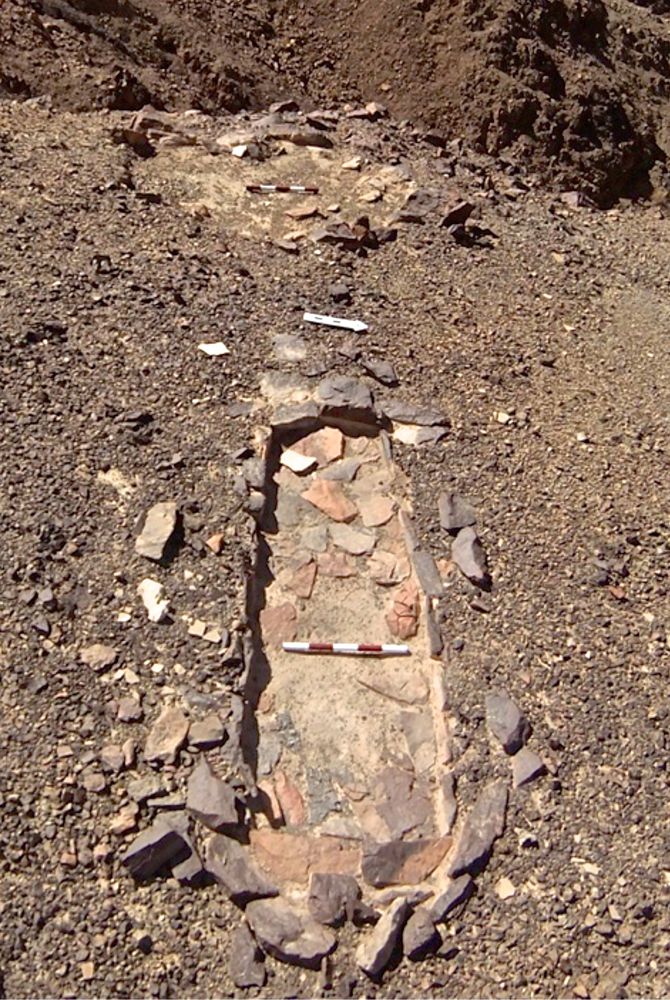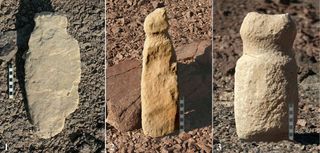100 Ancient Cult Sites Discovered in Israel

Some 100 prehistoric "cult sites," complete with penis stone structures and artifacts with vulva shapes cut into them, have been discovered in the Eilat Mountains, an extremely arid area of the Negev Desert in Israel.
At the sites, which date back around 8,000 years, archaeologists discovered a variety of stone structures and artifacts, including stone circles that measure 1.5 to 2.5 meters across (roughly 5 to 8 feet) with penis-shaped installations pointing toward them. Other findings there include standing stones that reach up to 2.6 feet (80 centimeters) high, stone bowls and stone carvings that have a humanlike shape.
These sites are often clustered together. In one area the team discovered 44 cult sites in a spot encompassing only 0.8 square kilometers (less than 200 acres). "Taking in[to] consideration the topography, environmental conditions and the small number of known Neolithic habitations in the general southern Negev, the density of cult sites in this region is phenomenal," the team wrote in an article published recently in the Journal of the Israel Prehistoric Society. [See Photos of the Cult Sites and Stone Structures]
These sites were used for ritual activities of some form. Archaeologists know little about what activities went on at these sites although animal sacrifice, as seen from bones found there, seems to be one of them.
Fertility and death
Archaeologists are working to decipher any meaning from the artifacts and structures, noting that both death and fertility seem to be symbolized at the sites.
For instance, in addition to the penis-shaped structures, researchers also found that some of the stones have vulva-shaped holes cut into them. The circles that the penis-shaped structures point to also seem to represent females.
Sign up for the Live Science daily newsletter now
Get the world’s most fascinating discoveries delivered straight to your inbox.
"The circle is a female symbol, and the elongated cell is a male one (phallus)," said Uzi Avner, a researcher with the Arava-Dead Sea Science Center and the Arava Institute, in an email to Live Science.

Death is "signified by the burial of stone objects and by setting them upside down," the team members wrote in their paper. In one case, a humanlike stone carving was found buried "with only the very top visible on the surface."
The two symbols identified so far, fertility and death, go hand in hand in many cultures. "Combinations of both are actually well-known in anthropological studies as relating to ancestral cult," the archaeologists wrote.
Harsh landscape
The 100 cult sites were found in a mountainous area that receives only 20 mm (0.79 inches) of rain per year, on average, the archaeologists said.
Around 8,000 years ago it would have been somewhat wetter. "The climate of the 7th-6th millennia B.C. was a little moister than that of the present, 40%-20% more rainfall, but the desert was a desert," said Avner in the email.
The cult sites tended to be built in relatively flat sections of the mountains. "Their position on topographic 'shoulders' or comparatively flat locations probably enabled several dozens of people to gather around them, for example, an extended family," the archaeologists wrote.
The sites also provide a good view. "Commonly, a broad view is seen from the sites, so possibly, the scenery was one element in the selection of their location," the archaeologists added.
While the researchers discovered many cult sites, they found few domestic ones. "In contrast to the density of cult sites, only two small habitations and one small campsite were found on the ridge," they wrote, noting that these three sites were all associated with the cult sites.
More cult sites to discover
Many more sites in the area remain to be surveyed and described in published papers, Avner told Live Science. A "survey of a larger area yielded to date 349 cult sites," he said, adding that researchers are preparing these finds for publication.
"The number of cult sites recorded to date suggests that many more still await discovery," the researchers wrote."Many more may be found on the mountains of the Negev, southern Jordan and Sinai."
One "may think now of a vast phenomenon, of hundreds of mountain cult sites in the desert."
Follow us @livescience, Facebook & Google+. Original article on Live Science.

Owen Jarus is a regular contributor to Live Science who writes about archaeology and humans' past. He has also written for The Independent (UK), The Canadian Press (CP) and The Associated Press (AP), among others. Owen has a bachelor of arts degree from the University of Toronto and a journalism degree from Ryerson University.
Most Popular

